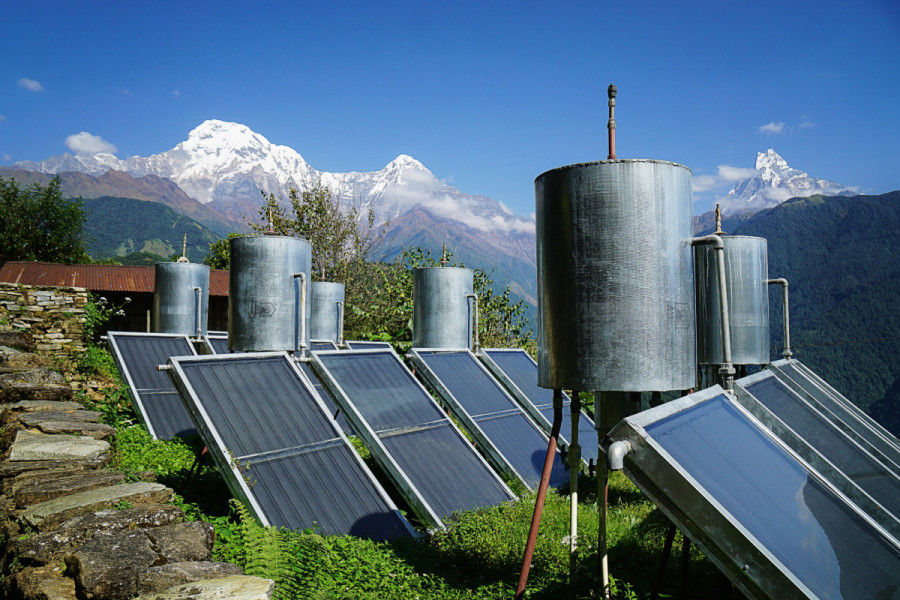Columns
Renewables and climate change in Nepal
Nepal is expanding mega hydropower projects and national-grid systems to ensure nationwide electricity.
Suman Acharya
Energy is a fundamental need of every individual and a crucial tool for the economic development of any nation. However, there remains a big question regarding the choice of energy in relation to climate change as they have a cause-and-effect relationship. Renewable energy technologies (RET) are widely adopted to solve the problems generated by climate change from global to regional to local scales. The first impression of such technologies in the contemporary world is that they are vital in reducing greenhouse gas (GHG) emissions as a climate mitigation tool. Similarly, their utility is pronounced socially, economically and politically as a means of climate adaptation strategies. An inverse relationship exists between RETs and climate change. However, the production, installation and utility of RETs still emit a certain amount of GHG.
Global-Nepal energy status
The contribution to global and national energy demand is still heavily reliant on non-renewable sources despite the higher demand for RETs. At the global scale, a significant proportion of energy demand is fulfilled by oil (33 percent), followed by coal (27 percent), nuclear energy (6 percent), and renewable energy (13 percent). In Nepal, a higher proportion of energy demand is for domestic purposes. It is shared by conventional energy sources, which account for 68.74 percent of total energy, followed by fossil fuels (18.23 percent), electricity (3.88 percent), and renewable energy (3.21 percent).
Several databases show that the extensive use of RETs in generating and fulfilling energy demand from renewable energy slower than expected. This will halt the targets set to meet climate change mitigation and adaptation at global and national scales. Although Nepal shares only 0.027 percent of total GHG emissions, it must reduce emissions through policies and programmes at all scales to support the global and national net-zero emission targets. The country has set this target for 2045 through the second Nationally Determined Contribution (NDC) under the Paris Agreement. Additionally, Nepal should augment the production and use of RETs from diverse sources to support rural communities in climate adaptation. However, despite being extremely rich in several RETs, including hydropower, solar and wind source, Nepal must catch up in generating extensive energy from RETs.
RETs for mitigation and adaptation
Nepal’s potential to promote climate change mitigation through RETs is exceptionally high. The country hosts approximately 2.2 percent of total global water resources supporting more than 6,000 rivers, longer sunshine (6.8 hours average per day), and high mountains with strong wind flow. These could harness a larger quantity of hydropower electricity, solar energy, and wind energy, respectively. By 2030, Nepal aims to supply 15 percent of the total energy through RETs as a mitigation strategy. In addition, transitioning from traditional firewood-based cooking systems to improved cooking systems will reduce a large share of Nepal’s GHG emissions because energy is the second largest sector of GHG emissions here. Furthermore, Nepal is expanding mega hydropower projects and the national-grid system to ensure electricity across the nation. Likewise, the country aims to transition from petroleum to electricity vehicles by securing 25 percent of private and 20 percent of public vehicle sales to be electronic by 2025. This transition would help reduce Nepal’s emissions by 8 percent. Similarly, by 2030, Nepal aims to cover 90 percent of all private vehicle sales and 60 percent of all public vehicle sales to electronic to reduce GHG emissions by 28 percent.
Regarding climate change adaptation, replacing conventional energy systems with RETs will serve in climate change adaptation in Nepal. Particularly, the country’s climate-vulnerable communities particularly benefit from RETs at the household level. The security of adaptation at the lowest scale is a must to ensure the nation’s climate adaptation. For instance, reducing the time and effort of women and children in searching for firewood, decreasing health issues and deaths from indoor air pollution, promoting quality education, etc., are some forms of adaptation benefits achieved by promoting RETs. In addition, under the clean development mechanism, Nepal has generated some revenue by selling carbon by replacing conventional energy sources with RETs, an economic adaptation to climate change.
Nepal’s hurdles in RETs expansion
Although Nepal seems progressive in generating benefits from RETs to meet climate change mitigation and adaptation, the pace is slow. For instance, Nepal’s first NDC in 2016 aimed to expand the energy mix by focusing on renewables by 20 percent, and the second NDC in 2020 aimed to ensure 15 percent of the total energy demand supplied by RETs. Behind these international pledges, Nepal’s RET has expanded by only 0.91 percent between 2016 and 2020. At this pace, Nepal will not be able to fulfil its pledges in RETs and ultimately fails to meet climate adaptation and mitigation aims. The consumption of petroleum products has increased by more than 2 percent between Nepal’s first (2016) and second (2020) NDCs. This trend reflects negative results in transitioning electric vehicles from petroleum vehicles. Similarly, Nepal’s energy consumption is highly dominated by hydropower rather than prioritising other RETs in energy composition. Nepal’s political instability, lack of staff, knowledge, financial resources, and authority to plan and decide policy at the provincial and local levels have hindered the expansion of RETs at lower scales.
Recommendations to Nepal
Having identified some hurdles in RETs expansion, there are certain recommendations to the Government of Nepal on RETs expansion in promoting climate mitigation and adaptation. First, Nepal should set achievable targets based on its resources, knowledge, and technologies. It should prepare a sustainable energy composition policy to design a mixed portfolio or RETs rather than just focusing on the monolithic expansion of hydropower.
Similarly, it is important to enhance bottom-up climate mitigation and adaptation strategies because Nepal’s local climate change problems are visible. So RETS must be focused at the local level by decentralising the energy system. Nepal might face several obstacles due to geographic, social, economic, administrative and political barriers. Although Nepal adopted federalism in 2015 with fully functional local government units, the rights and authority to decide RET policies, programmes, knowledge, and other resources are still at the central level. All of these, in addition to the larger national grid and other energy sources, should be decentralised at the provincial and local levels. This will help expand micro-hydro power, wind energy, and lower-scale solar plants. Finally, the legislative, executive and judicial authorities should be handed over to local units in developing new energy policies based on regional scenarios with secured climate change adaptation and mitigation mainstreamed to accomplish national and international GHG emissions reduction pledges.




 19.12°C Kathmandu
19.12°C Kathmandu















